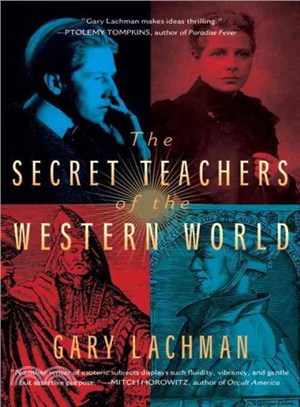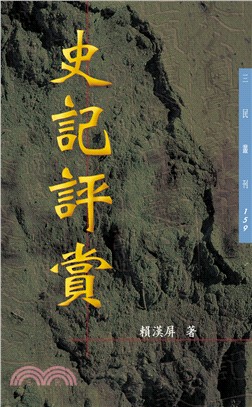The Secret Teachers of the Western World
商品資訊
ISBN13:9780399166808
出版社:Penguin Group USA
作者:Gary Lachman
出版日:2015/12/08
裝訂/頁數:平裝/416頁
規格:22.9cm*15.2cm*3.2cm (高/寬/厚)
商品簡介
作者簡介
相關商品
商品簡介
This epic study unveils the esoteric masters who have covertly impacted the intellectual development of the West, from Pythagoras and Zoroaster to the little-known modern icons Jean Gebser and Schwaller de Lubicz.
Running alongside the mainstream of Western intellectual history there is another current which, in a very real sense, should take pride of place, but which for the last few centuries has occupied a shadowy, inferior position, somewhere underground.
This "other" stream forms the subject of Gary Lachman’s epic history and analysis,The Secret Teachers of the Western World.
In this clarifying, accessible, and fascinating study, the acclaimed historian explores the Western esoteric tradition – a thought movement with ancient roots and modern expressions, which, in a broad sense, regards the cosmos as a living, spiritual, meaningful being and humankind as having a unique obligation and responsibility in it. This is in stark contrast to much of modern science, which sees the universe as a meaningless flow of matter and energy, and human beings as pointless accidents within it.
The historical roots of our “counter tradition,” as Lachman explores, have their beginning in Alexandria around the time of Christ. It was then that we find the first written accounts of the ancient tradition, which had earlier been passed on orally. Here, in this remarkable city, filled with teachers, philosophers, and mystics from Egypt, Greece, Asia, and other parts of the world, in a multi-cultural, multi-faith, and pluralistic society much like our own, a synthesis took place, a creative blending of different ideas and visions, which gave the hidden tradition the eclectic character it retains today.
We can see the history of our esoteric tradition as roughly forming three parts:
Part One: After looking back at the earliest roots of the esoteric tradition in the mysteries of ancient Egypt and Greece, the historical narrative opens in Alexandria in the first centuries of the Christian era. Over the following centuries, it traces our “other” tradition through such agents as the Hermeticists, Kabbalists; Gnostics; Neoplatonists; and early Church fathers, among many others. Part One examines the reemergence of the lost Hermetic books in the Renaissance and their powerful influence on the emerging modern mind.
Part Two begins with the fall of Hermeticism in the late Renaissance and the beginning of what we can call “the esoteric counterculture.” In 1614, the same year that the Hermetic teachings fell from grace, a strange document in Kassel, Germany announced the existence of a mysterious spiritual fraternity: the Rosicrucians. This second part charts the impact of the Rosicrucians and the many esoteric currents that followed, such as the Romance movement and the European occult revival of the late nineteenth century, including Madame Blavatsky and the opening of the western mind to the wisdom of the East, and the fin-de-siecle occultism of the Hermetic Order of the Golden Dawn.
Finally, Part Three chronicles the rise of “modern esotericism,” as seen in the work of teachers such as Rudolf Steiner, Gurdjieff, Annie Besant, Krishnamurti, Aleister Crowley, R. A Schwaller de Lubicz, and many others. It traces the influence that they and other modern teachers have had on mainstream western culture. Central in this part is the life and work of C.G. Jung, perhaps the most important figure in the development of modern spirituality. The book looks at the occult revival of the “mystic sixties” and our own New Age, and how this itself has given birth to a more critical, rigorous investigation of the ancient wisdom, and to the spread of Gnostic (The Matrix) and Hermetic (Harry Potter) ideas in popular culture.
With many detours and dead ends, we now seem to be slowly moving into a watershed, in which it has become clear that the dominan
Running alongside the mainstream of Western intellectual history there is another current which, in a very real sense, should take pride of place, but which for the last few centuries has occupied a shadowy, inferior position, somewhere underground.
This "other" stream forms the subject of Gary Lachman’s epic history and analysis,The Secret Teachers of the Western World.
In this clarifying, accessible, and fascinating study, the acclaimed historian explores the Western esoteric tradition – a thought movement with ancient roots and modern expressions, which, in a broad sense, regards the cosmos as a living, spiritual, meaningful being and humankind as having a unique obligation and responsibility in it. This is in stark contrast to much of modern science, which sees the universe as a meaningless flow of matter and energy, and human beings as pointless accidents within it.
The historical roots of our “counter tradition,” as Lachman explores, have their beginning in Alexandria around the time of Christ. It was then that we find the first written accounts of the ancient tradition, which had earlier been passed on orally. Here, in this remarkable city, filled with teachers, philosophers, and mystics from Egypt, Greece, Asia, and other parts of the world, in a multi-cultural, multi-faith, and pluralistic society much like our own, a synthesis took place, a creative blending of different ideas and visions, which gave the hidden tradition the eclectic character it retains today.
We can see the history of our esoteric tradition as roughly forming three parts:
Part One: After looking back at the earliest roots of the esoteric tradition in the mysteries of ancient Egypt and Greece, the historical narrative opens in Alexandria in the first centuries of the Christian era. Over the following centuries, it traces our “other” tradition through such agents as the Hermeticists, Kabbalists; Gnostics; Neoplatonists; and early Church fathers, among many others. Part One examines the reemergence of the lost Hermetic books in the Renaissance and their powerful influence on the emerging modern mind.
Part Two begins with the fall of Hermeticism in the late Renaissance and the beginning of what we can call “the esoteric counterculture.” In 1614, the same year that the Hermetic teachings fell from grace, a strange document in Kassel, Germany announced the existence of a mysterious spiritual fraternity: the Rosicrucians. This second part charts the impact of the Rosicrucians and the many esoteric currents that followed, such as the Romance movement and the European occult revival of the late nineteenth century, including Madame Blavatsky and the opening of the western mind to the wisdom of the East, and the fin-de-siecle occultism of the Hermetic Order of the Golden Dawn.
Finally, Part Three chronicles the rise of “modern esotericism,” as seen in the work of teachers such as Rudolf Steiner, Gurdjieff, Annie Besant, Krishnamurti, Aleister Crowley, R. A Schwaller de Lubicz, and many others. It traces the influence that they and other modern teachers have had on mainstream western culture. Central in this part is the life and work of C.G. Jung, perhaps the most important figure in the development of modern spirituality. The book looks at the occult revival of the “mystic sixties” and our own New Age, and how this itself has given birth to a more critical, rigorous investigation of the ancient wisdom, and to the spread of Gnostic (The Matrix) and Hermetic (Harry Potter) ideas in popular culture.
With many detours and dead ends, we now seem to be slowly moving into a watershed, in which it has become clear that the dominan
作者簡介
Gary Lachman is one of today’s most respected writers on esoteric and occult themes. His many books -- includingMadame Blavatsky, Swedenborg, Jung the Mystic, and Rudolf Steiner -- have received international acclaim. He has appeared on many television and radio programs and is an adjunct professor in the Evolution of Consciousness at the California Institute of Integral Studies. A founding member of the band Blondie, Lachman has been inducted into the Rock and Roll Hall of Fame. He lives in London.
主題書展
更多
主題書展
更多書展今日66折
您曾經瀏覽過的商品
購物須知
外文書商品之書封,為出版社提供之樣本。實際出貨商品,以出版社所提供之現有版本為主。部份書籍,因出版社供應狀況特殊,匯率將依實際狀況做調整。
無庫存之商品,在您完成訂單程序之後,將以空運的方式為你下單調貨。為了縮短等待的時間,建議您將外文書與其他商品分開下單,以獲得最快的取貨速度,平均調貨時間為1~2個月。
為了保護您的權益,「三民網路書店」提供會員七日商品鑑賞期(收到商品為起始日)。
若要辦理退貨,請在商品鑑賞期內寄回,且商品必須是全新狀態與完整包裝(商品、附件、發票、隨貨贈品等)否則恕不接受退貨。
























